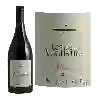
Winery Les Remparts de CucullesCuvée Hector Pic Saint Loup
This wine generally goes well with beef, veal or pasta.
Food and wine pairings with Cuvée Hector Pic Saint Loup
Pairings that work perfectly with Cuvée Hector Pic Saint Loup
Original food and wine pairings with Cuvée Hector Pic Saint Loup
The Cuvée Hector Pic Saint Loup of Winery Les Remparts de Cuculles matches generally quite well with dishes of beef, pasta or veal such as recipes of borscht (russia), salmon lasagna or veal cutlets parmigiana.
Details and technical informations about Winery Les Remparts de Cuculles's Cuvée Hector Pic Saint Loup.
Discover the grape variety: Genovèse
Genovese blanc is a grape variety that originated in France (Corsica). It produces a variety of grape specially used for wine making. It is rare to find this grape to eat on our tables. Genovese blanc can be found cultivated in these vineyards: South-West, Cognac, Bordeaux, Provence & Corsica, Rhone Valley.
Informations about the Winery Les Remparts de Cuculles
The Winery Les Remparts de Cuculles is one of of the world's greatest estates. It offers 10 wines for sale in the of Pic-Saint-Loup to come and discover on site or to buy online.
The wine region of Pic-Saint-Loup
The wine region of Pic-Saint-Loup is located in the region of Languedoc of Languedoc-Roussillon of France. Wineries and vineyards like the Domaine Ermitage du Pic Saint Loup or the Domaine de Villeneuve produce mainly wines red, pink and white. The most planted grape varieties in the region of Pic-Saint-Loup are Mourvèdre, Roussanne and Viognier, they are then used in wines in blends or as a single variety. On the nose of Pic-Saint-Loup often reveals types of flavors of earth, straw or apricot and sometimes also flavors of peach, dark chocolate or anise.
The wine region of Languedoc-Roussillon
Languedoc (formerly Coteaux du Languedoc) is a key appellation used in the Languedoc-Roussillon wine region of southern France. It covers Dry table wines of all three colors (red, white and rosé) from the entire region, but leaves Sweet and Sparkling wines to other more specialized appellations. About 75% of all Languedoc wines are red, with the remaining 25% split roughly down the middle between whites and rosés. The appellation covers most of the Languedoc region and almost a third of all the vineyards in France.
The word of the wine: Nouaison
Phase of the vegetative cycle of the vine following flowering and corresponding to the formation of the grape berry.














